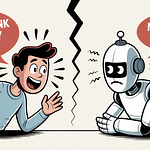In a quiet, sun-dappled park, a gray quadruped robot is kicked and hit with a stick. Its body jerks, its legs flail, and then—seamlessly—it regains its footing and keeps moving, dancing almost with eerie grace. The video is titled “Robot Dog Keeps Its Balance,” but it might as well have been called “How to Build Sympathy for a Machine.”
This footage of a Unitree robot dog being hit and tossed around—part of what appears to be a stress test—has sparked more than just curiosity. It has struck a cultural nerve, illuminating an unsettling intersection of technology, emotion, and ethics.
Why Watching a Robot Get Hit Feels So Wrong
To be clear: the Unitree robot is not alive. It does not feel pain. It has no consciousness, no fear, no emotional core. And yet, tens of thousands of viewers flooded the video’s comment section with concern, humor, and horror:
“Why do I feel so bad for the robot dog?”
“Robot or not, it’s still a dog. Please stop hurting it.”
“Bro why are you throwing him like dat 😭💀”
“This is what’s gonna cause the robot rebellion.”
A notable faction of viewers reacted with dark humor, imagining a Terminator-esque future of revenge-seeking droids. Others mused about whether such abuse was laying the groundwork for robot resentment—an ironic twist given the lack of sentience.
Still, a quieter but potent thread emerged: unease. Why does this feel cruel, even though we know it’s not alive?
Ethics for Robots vs. Ethics of Robots
Robot ethics, as a discipline, branches in two directions:
Ethics for robots: How should we design machines to behave ethically, especially when they interact with humans? Think self-driving cars making split-second decisions, or carebots prioritizing patient needs.
Ethics of robots: How should humans behave toward machines, especially those that mimic life? Should empathy extend beyond the biological?
The Unitree dog raises the latter question in stark relief. It's not just about code—it's about conduct.
Mimicry, Empathy, and the Cognitive Dissonance
What happens when a machine begins to look like something alive? The dog-like form of the Unitree evokes a primal empathy—an involuntary emotional response drawn from millions of years of human evolution. The motion, the balance, even the helpless tumbling: it mimics suffering. And mimicry, it turns out, may be enough to spark an ethical question.
This is not new. Research shows humans form emotional bonds with robots that display social cues, even in primitive forms. In 2007, researchers found that soldiers deployed with bomb-defusing robots would hold impromptu funerals for them when destroyed in action. In other cases, people apologized to Roombas after kicking them.
So what happens when those robots aren’t toys or tools—but companions, pets, or caregivers?
Robot Rights? Or Human Responsibility?
Some commenters on the video joked—or half-joked—about robo-animal rights:
“We should have robo animal rights.”
“That’s robotic animal abuse.”
“Better hope robots don’t hold a grudge.”
They tap into something deeper: even if machines don’t suffer, our behavior toward them still reflects something about us.
The way we treat robots, especially those designed to be lifelike, could shape how we treat vulnerable humans. If empathy is a muscle, does mistreating a lifelike robot weaken it?
Researchers in Human-Robot Interaction (HRI) argue that consistent cruelty toward anthropomorphic machines can desensitize people. Especially children. Especially over time.
The Specter of Revenge: From Fiction to Forecast
Commenters couldn’t resist invoking Skynet or imagining a sentient uprising. While these scenarios remain the stuff of fiction (for now), they point to a cultural unease: as machines become more autonomous, our moral imagination is struggling to keep pace.
When machines make decisions—especially violent ones, like in autonomous weapons systems—who bears the moral burden? The designer? The algorithm? The user?
The moment we project autonomy and intention onto a machine—even in jest—we are acknowledging the blurred line between tool and agent.
Speculative Futures: Do Android Dogs Dream of Electric Justice?
Fast forward two decades. Your aging parent lives alone with a robotic caregiver. It brings them water, reminds them to take meds, and tells them jokes. One day, a guest swats it in annoyance.
Does that action matter? Should it be illegal? Could it erode the dignity of the elder who depends on it?
The question is no longer if machines will evoke moral consideration—but when, why, and how much.
And while most roboticists agree we don’t need to grant rights to machines anytime soon, they do warn: our behavior toward them is rehearsing our future norms.
Final Thoughts: The Mirror in the Machine
That video of the Unitree dog isn’t just a stress test. It’s a cultural Rorschach test. Some saw innovation. Others saw cruelty. Many saw comedy, cloaked in unease.
But maybe the most profound takeaway is this: as machines become more lifelike, they also become mirrors—reflecting back our capacity for empathy, aggression, humor, and morality.
The real ethical challenge isn’t whether the robot feels pain. It’s whether we do—and whether we care when we stop.
If you felt bad for the robot dog, or slightly concerned about a machine uprising… you’re in the right place.
Subscribe to Deep Learning with the Wolf—where we wrestle with AI, ethics, and the occasional existential crisis.
roboethics #ai #futuretech #moralphilosophy #automationethics #robotrights #aiethics #technoculture #humanvalues #artificialintelligence #deeplearningwiththewolf














Share this post